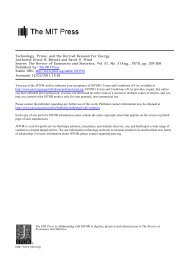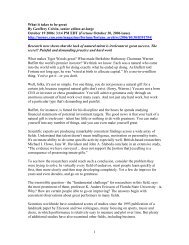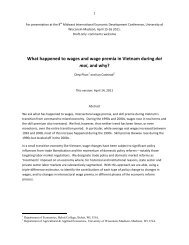Capital-Labor Substitution and Economic Efficiency Author(s): K. J. ...
Capital-Labor Substitution and Economic Efficiency Author(s): K. J. ...
Capital-Labor Substitution and Economic Efficiency Author(s): K. J. ...
You also want an ePaper? Increase the reach of your titles
YUMPU automatically turns print PDFs into web optimized ePapers that Google loves.
CAPITAL-LABOR SUBSTITUTION AND ECONOMIC EFFICIENCY 233<br />
of capital varies from country to country, but<br />
not the efficiency of use of labor.<br />
A more symmetrical (<strong>and</strong> more plausible)<br />
possibility is that international differences in<br />
efficiency affect both inputs equally. This<br />
amounts to assuming in (13) that the efficiency<br />
parameter y varies from country to country<br />
while 8 <strong>and</strong> p remain constant. Since //a<br />
= 8/(i-8), we can put this by saying that /8<br />
<strong>and</strong> a vary proportionately. We can provide a<br />
test of this hypothesis.<br />
From the definition of the elasticity of sub-<br />
stitution <strong>and</strong> its constancy <strong>and</strong> the competitive<br />
equivalence of factor price ratios <strong>and</strong> marginal<br />
rates of substitution, it follows that w/r is pro-<br />
portional to (K/L)'10 = (K/L)(1+P). It is easy<br />
enough to calculate the constant of proportion-<br />
ality directly; we have<br />
W I8 K Al+P<br />
r 8 L (20)<br />
<strong>and</strong><br />
2/a /=/(I 8) = (r) (K )l+P (2I)<br />
Thus for countries from which we have data on<br />
r <strong>and</strong> K, <strong>and</strong> given our estimate of p for an<br />
industry, we may compare the values of the<br />
right-h<strong>and</strong> side of (2I). If they are constant<br />
or nearly so, we conclude that there are neutral<br />
variations in efficiency from country to country,<br />
<strong>and</strong> we are able simultaneously to estimate 8.<br />
Then from 8 <strong>and</strong> p we can use (I2) to estimate<br />
the efficiency parameter y in each country involved,<br />
for this particular industry.<br />
4. Factor intensity <strong>and</strong> the CES production<br />
f unction. From (20) we see that:<br />
K w<br />
X = ~=(~Y.(2 oa)<br />
L I-S rJ 2a<br />
Now imagine two industries each with a CES<br />
production function although with different<br />
parameters, <strong>and</strong> buying labor <strong>and</strong> capital in the<br />
same competitive market. Then<br />
X1 8 1 Aal 82 A-2 W Aa-2<br />
X2 I-81 I -82 r<br />
wy- W( r2) (22)<br />
If 01 =0 (i.e., Pi = P2), then this relative fac-<br />
tor-intensity ratio is independent of the factor<br />
price ratio. That is, industry one, say, is more<br />
capital-intensive than industry two, at all pos-<br />
sible price ratios. This is the case both for the<br />
Cobb-Douglas function (o-, = 0-2 = i) <strong>and</strong> the<br />
fixed-proportions case (o-, = 0-2 = a). But once<br />
O- z o-2, this factor-intensity property disap-<br />
pears <strong>and</strong> it is impossible to characterize one<br />
industry as more capital-intensive than the<br />
other independently of factor prices. For (22)<br />
says quite clearly that there is always a critical<br />
value of w/r at which the factor-intensity ratio<br />
x1/x2 flips over from being greater than unity<br />
to being less. There is only one such critical<br />
value at which the industries change places with<br />
respect to relative capital-intensity. The nature<br />
of the switch is in accord with common sense:<br />
as wages increase relative to capital costs, ulti-<br />
mately the industry with the greater elasticity<br />
of substitution becomes more capital-intensive.<br />
Such switches in relative factor intensity should<br />
be observable if one compares countries with<br />
very different factor-price structures, which we<br />
have done for Japan <strong>and</strong> the United States in<br />
section IV.<br />
The relative factor-intensity ratio plays an<br />
important role in discussions of the tendency of<br />
international trade in commodities to equalize<br />
factor prices in different countries (<strong>and</strong> for that<br />
matter, in the more general problem of the rela-<br />
tion between factor prices <strong>and</strong> commodity prices<br />
in any general equilibrium system).<br />
5. Time series <strong>and</strong> technological change. The<br />
CES production function is intrinsically diffi-<br />
cult to fit directly to observations on output <strong>and</strong><br />
inputs because of the non-linear way in which<br />
the parameter p enters. But, provided technical<br />
change is neutral or uniform, we may use the<br />
convenient factor-price properties of the func-<br />
tion to analyze time series <strong>and</strong> to estimate the<br />
magnitude of technical progress.<br />
A uniform technical change is a shift in the<br />
production function leaving invariant the mar-<br />
ginal rate of substitution at each K/L ratio.<br />
From (I3) <strong>and</strong> (20), uniform technical prog-<br />
ress affects only the efficiency parameter y, <strong>and</strong><br />
not the substitution or distribution parameters,<br />
p or o-.<br />
One notes from (20) that<br />
wL i-8 ( K \P<br />
rK 8 L(23)<br />
which is independent of y. Hence if historical<br />
shifts in a CES function are neutral, (23) should







